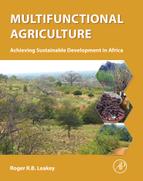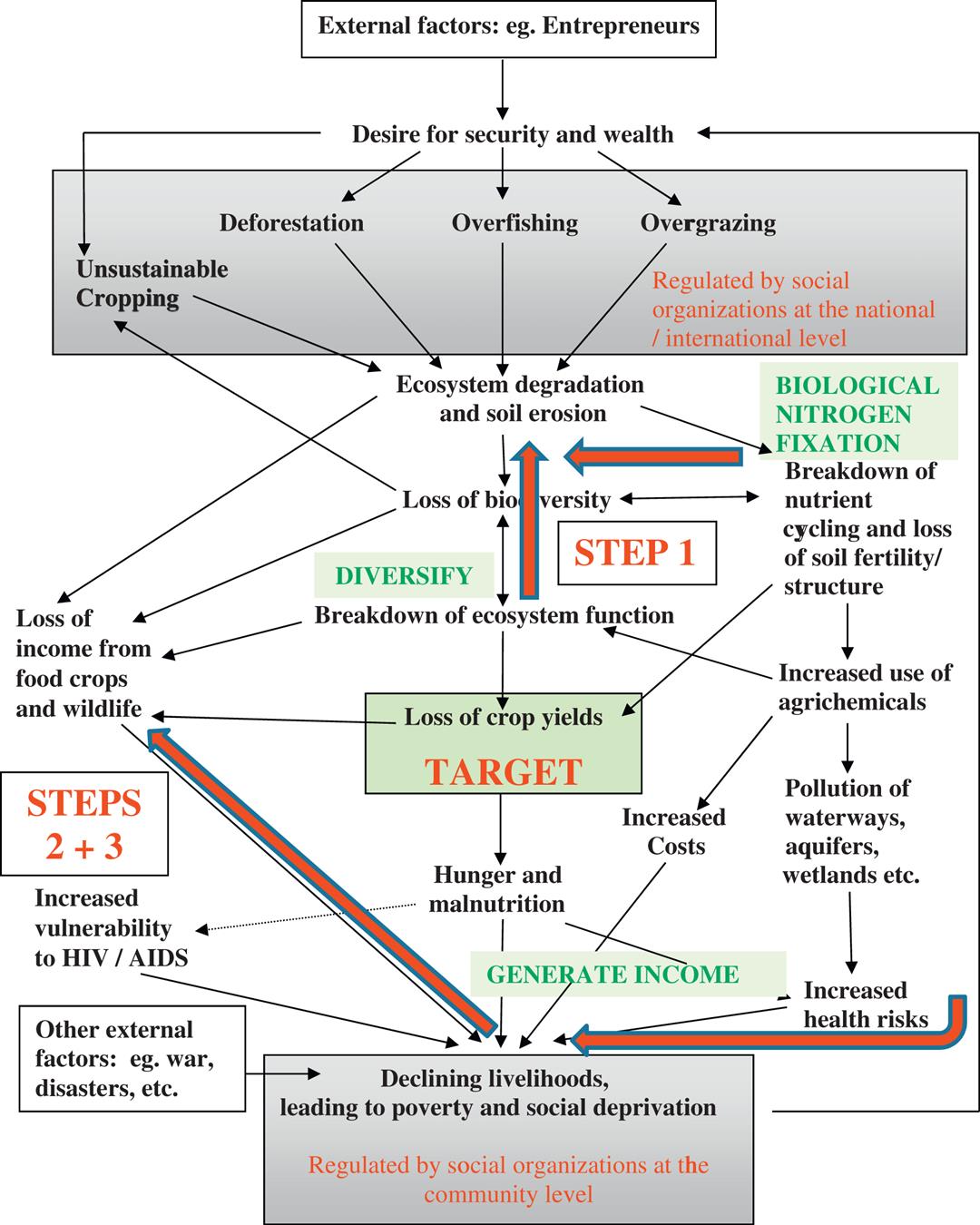Addressing the Causes of Land Degradation, Food/Nutritional Insecurity and Poverty: A New Approach to Agricultural Intensification in the Tropics and Sub-Tropics
This chapter was previously published in Leakey, R.R.B., 2013. In: Hoffman, U. (Ed.), Wake Up Before It Is Too Late: Make Agriculture Truly Sustainable Now for Food Security in a Changing Climate, UNCTAD Trade and Environment Review 2013. UN Publications, Geneva, Switzerland, pp. 192–198 (Chapter 3), with permission from United Nations
Abstract
The benefits of the Green Revolution have come at a high environmental and social cost in the tropics, with land degradation and poverty now the main constraints to productivity in developing countries. This results in a complex downward spiral of interacting environmental, social and economic factors which gives rise to a “yield gap” between the potential yield of staple food crops and the actual yield achieved by smallholder farmers. Calls for greater sustainability echo with statements that “business as usual” is no longer appropriate–raising the following questions: “How can the land be used to feed a growing population without further damage to the local and global environment?”, “How can food and nutritional security be achieved on a declining area of available land?” and “How can the land be used to enhance the livelihoods and income of those in poverty?” Solutions? This chapter examines a novel approach to agricultural intensification which combines an appropriate agroecological approach to restoring soil fertility and ecological health with income generation. A practical and generic three-step model is proposed, which closes the yield gap and reverses the spiral of land degradation and social deprivation, so enhancing food and nutritional security and reducing poverty. This involves the on-farm, community-level domestication of underutilized indigenous food and non-food species as new cash crops, and the subsequent development of new local processing industries for further income and employment.
Keywords
Agroecology; agroforestry; commercialization; deforestation; domestication; cycle of land degradation; income generation; intensification; nitrogen fixation; poverty; social deprivation; three-step generic model
The productivity of conventional high-input agriculture has been greatly increased by the achievements of the Green Revolution, saving millions of people from starvation. However, this achievement came at a high environmental cost in terms of land conversion from forest (deforestation), land degradation, and the overexploitation of natural resources—especially soil and water. It is now also recognized as being a major contributor to climate change. Furthermore, despite the success of improved productivity of major food staples, there are still billions of people suffering from poverty, malnutrition and hunger. Consequently, there have been many calls for a new approach to food production, especially in the tropics and subtropics where the problems and issues are most urgent and prevalent. The key issues to be addressed are land rehabilitation, food and nutritional security and income generation—all within sustainable land-use practices. The overriding questions are: How can the land be used to feed a growing population without further damage to the local and global environment? How can food and nutritional security be achieved on a declining area of available land? How can the land be used to enhance the livelihoods and income of those in poverty?
Answers to these questions fall into two main camps: those that insist that the only way forward is an intensification of the high-energy input Green Revolution model involving further productivity improvements through new and exciting approaches to crop and livestock genetics, against those that think more ecologically based approaches to low-input agriculture are the way forward. To consider the merits of these two contrasting and highly polarized views, let’s look at the environmental and socioeconomic problems arising from land conversion to agriculture and then seek some solutions.
Current land-use practices in the tropics have led to deforestation, overgrazing and overexploitation of soils and water resources (Fig. 34.1), causing a cascade of negative impacts: land degradation, loss of soil fertility, loss of biodiversity, the breakdown of agro-ecosystem function, declining yields, hunger and malnutrition, and declining livelihoods. Associated with this is reduced access to traditional wild foods, loss of income, and the increased need for costly (often unaffordable) agricultural inputs. The response of proponents of intensive, high-input industrial farming is to redouble efforts to increase the yield of staple food crops by enhancing their capacity to withstand biotic and abiotic stress. This approach fails to recognize three important points: (1) farmers are failing to grow staple foods anywhere near their existing biological potential, creating what is called the Yield Gap (Fig. 34.2), so increasing the biological potential will not help; (2) poor smallholder farmers locked in the Poverty Trap cannot afford to buy the fertilizers and pesticides (even if they had adequate access to them) that would allow them to practice monoculture agriculture; and (3) the overriding dominance of starchy food staples in modern agriculture may provide adequate calories for survival, but they lack the protein and micronutrients for healthy living, not to mention the sensory pleasures of traditional and highly nutritious foods which used to be gathered from the forest. In addition, the widespread clearance of forest from the landscape, especially from hillsides, exposes soils to erosion and increases run-off, resulting in landslides and flooding that destroy property and cause the death of large numbers of people. Loss of perennial vegetation also contributes to climate change. In conclusion, therefore, an alternative approach to agricultural intensification is required, as several recent reviews of agriculture (IAASTD, 2009; Royal Society, 2009) and the role of agriculture in global environmental issues (e.g., MEA, 2005; GEO, 2007; CAWMA, 2007) have suggested that “business as usual” is no longer the appropriate option due to the scale of the problems and the constraints facing poor farmers.
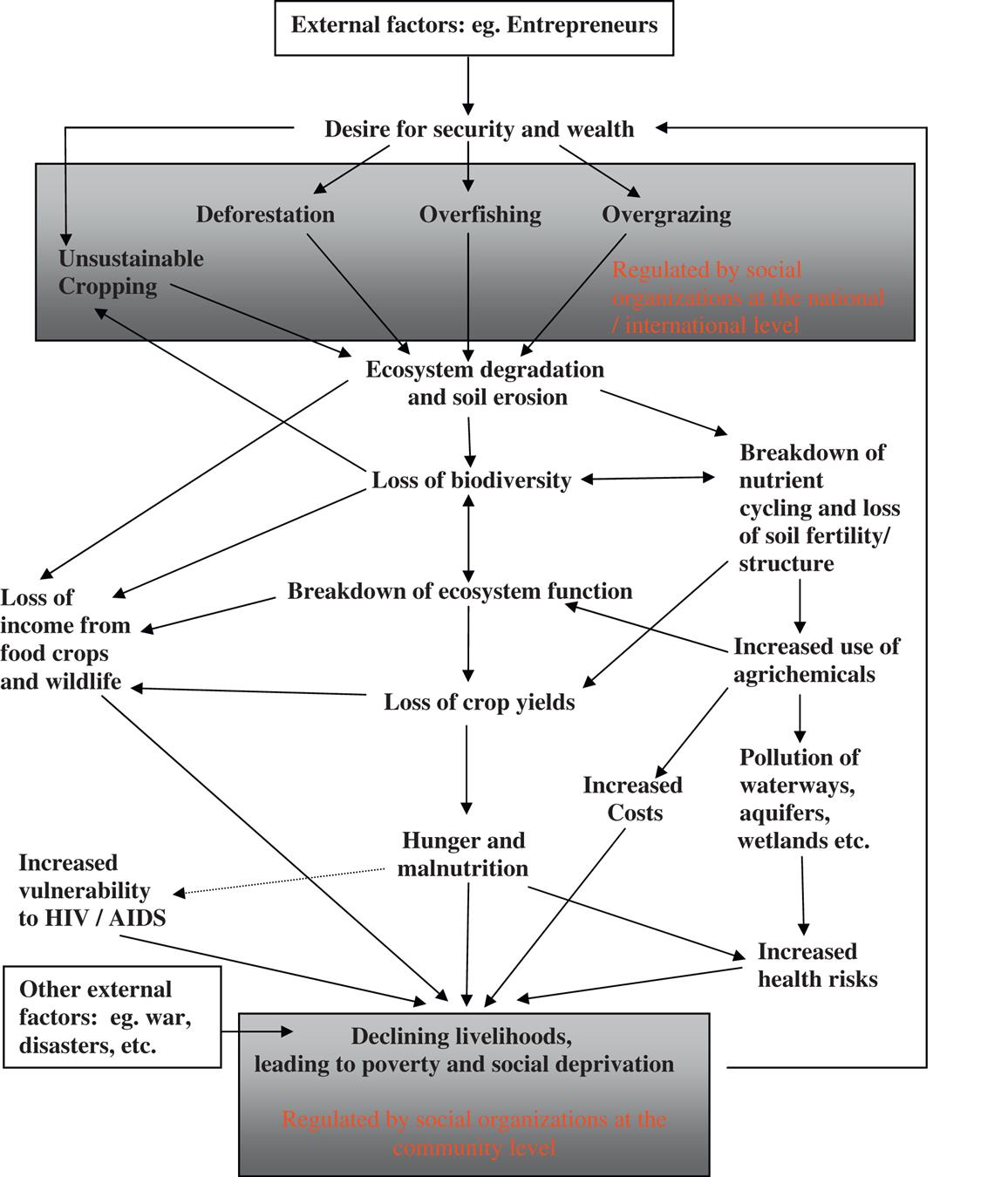
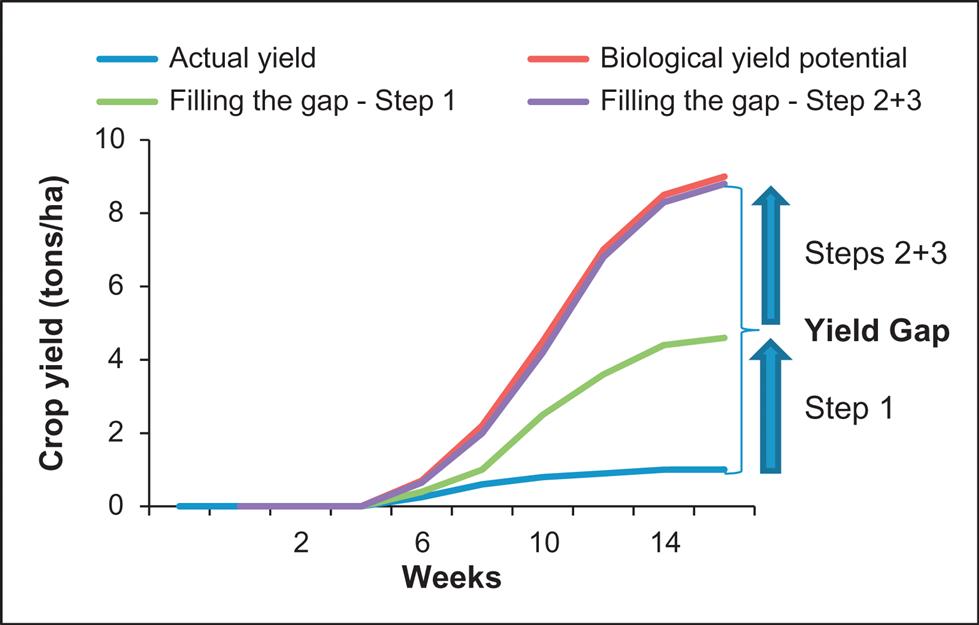
So, is there a better alternative? The answer is “yes.” Let’s go back to basics and look at the cycle of land degradation and social deprivation (Fig. 34.1). Clearly a focus on crop yield is important, but rather than trying to increase yield potential, let’s focus on closing the Yield Gap. In the worst cases farmers growing maize are achieving only 0.5–1.0 t ha−1 when the potential is around 10 t ha−1. In this situation, closing the Gap could increase food production by 15- to 20-fold; but even if it was only 2- to 3-fold on average, this is well over the 70% increase that might be required to feed the 9 billion people predicted to populate the world by 2050, according to IFPRI (2011).
The primary cause of the Yield Gap is poor crop husbandry, which leads to the loss of soil fertility and agroecosystem functions, such as the cycling of nutrient, carbon and water; the progress and operation of life cycles and food webs that maintain the natural balance between organisms; pollination and seed dispersal, etc. Typically, soil nitrogen is the prime constraint to crop growth in degraded soils. This can be restored by harnessing the capacity of certain legumes to fix atmospheric nitrogen in root nodules colonized by symbiotic bacteria (Rhizobium spp.). Numerous techniques have been developed to integrate appropriate legume species within farming systems. Probably the most effective and adoptable are high-density improved fallows with species like Sesbania sesban and Tephrosia vogelii or relay cropping with Gliricidia sepium (Cooper et al., 1996; Buresh and Cooper, 1999). Leguminous crops like beans and peanuts can also contribute to this process. Together the legumes will increase soil nitrogen to a level that will give maize yields of 4–5 t ha−1 within 2–3 years. In other words the Yield Gap is partially filled and food security is greatly increased. At this point, however, other soil nutrients are generally limiting and so the complete closure of the Yield Gap would require another approach involving the provision of inorganic nutrients, such as rock phosphate, or chemical fertilizers, which have to be purchased. So, the need now is to generate income.
However, before addressing the need for income, agroecosystem function has to be restored. The legumes will start this process. For example, one of the serious weeds of cereal crops like maize, millet and sorghum is Striga hermonthica. It is a root parasite on these cereals and its seeds germinate in response to root exudates from the young cereal plants. Interestingly, however, S. sesban and the fodder legumes Desmodium intortum and Desmodium uncinatum also trigger Striga germination, so they can be used to promote suicide germination in the absence of the cereal hosts (Khan et al., 2002). Desmodium spp. also acts as a repellent to insect pests of cereals, for example the stem borers Busseola fusca and Chilo partellus. Likewise, simple agroecological benefits can also be attained by planting Napier grass (Pennisetum purpureum) as an intercrop, or around small fields, as it attracts the pests away from the crops (Khan et al., 2006).
The two preceding interventions can therefore be used to restore soil fertility and initiate an agroecological succession, so rehabilitating farm land and reversing some of the land degradation processes. We can think of this as the first step towards closing the Yield Gap (Fig. 34.3).
Going the next step to a fully functional and more productive agroecosystem involves the integration of trees within the farming systems. Some trees are of course cash crops like coffee, cocoa and rubber, which in the past were either grown as large-scale monocultural plantations or as a two-species mixture, such as cocoa under the shade of coconuts or G. sepium. Increasingly, however, these are becoming smallholder crops grown in much more diverse species mixtures, such as bananas with fruits trees like mango, avocado and local indigenous trees producing marketable products (Leakey and Tchoundjeu, 2001). This is well developed in Latin America and Asia and is becoming widely recognized as a way to restore the biodiversity normally found in natural forests (Schroth et al., 2004; Clough et al., 2011). Certainly the replacement of shade trees with trees that also produce useful and marketable products is a good strategy for farmers wanting to maximize output from the land and to minimize the risks associated with reliance on a single crop species.
There has also been another silent farmer-led revolution in the tropics, especially in Southeast Asia. In Indonesia in particular, many farmers who used to practice shifting agriculture have replaced the natural fallow with a commercial fallow (agroforest) based on tree crops (Plate 34.1). They grow rice in the valley bottoms and plant a wide range of useful and commercially important tree species among the other food crops which they have planted on the valley slopes (Michon and de Foresta, 1999). These trees became productive in a succession in later years, creating a continuous supply of marketable produce (cinnamon, tung nut, damar, duku, rubber, etc.) for several decades—often ending in a timber crop. This diversification of the farming system with perennial crops therefore achieves several important outcomes. It protects sloping land from erosion, improving water infiltration into the soil; it sequesters carbon and so mitigates climate change; it generates income; it enhances biodiversity and promotes agroecosystem function—in other words it does all the things that large-scale monocultures fail to do and the livelihoods of the farmers are orders of magnitude better than those locked in poverty growing a failed maize crop in Africa. This approach to agriculture achieves high crop yields close to the biological potential on the best and most fertile land, and income generation from tree crops on the more marginal land, creating a land-use mosaic with many environmentally beneficial impacts (Plate 34.2). Importantly, there is also some evidence that complex perennial vegetation, such as natural forest or an agroforest, is better than an herbaceous crop at recycling moisture to the atmosphere to be advected downwind to fall as rain. Thus agroforests are likely to be beneficial to rainfed agriculture in dry and drought-prone areas of the world.
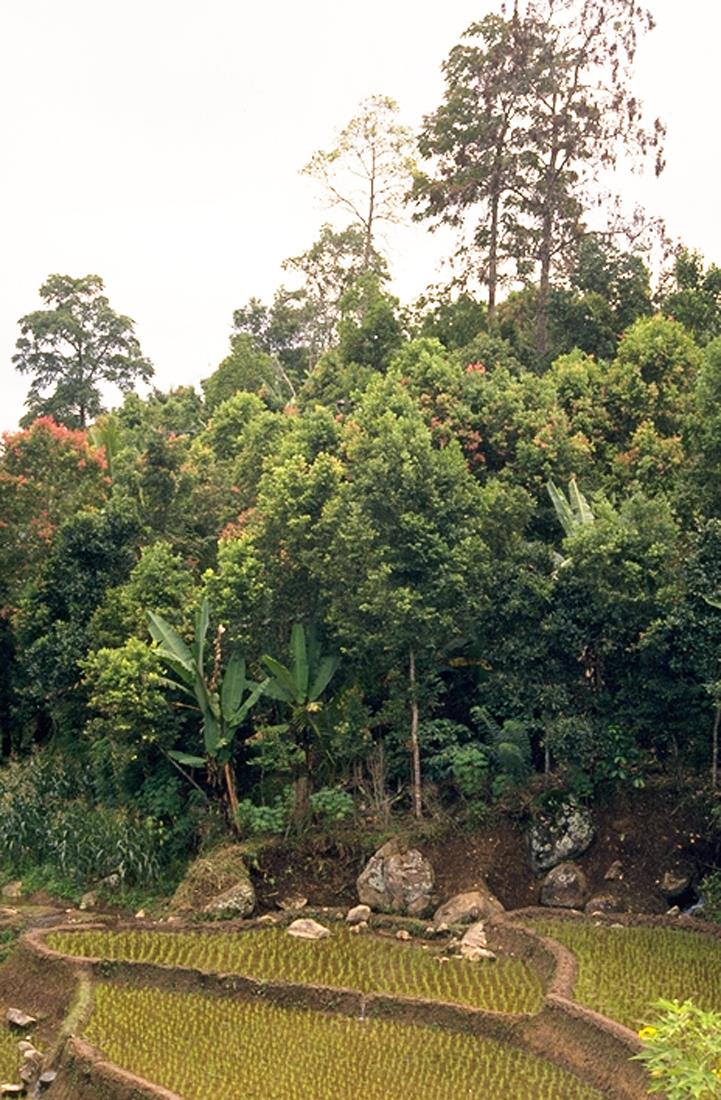
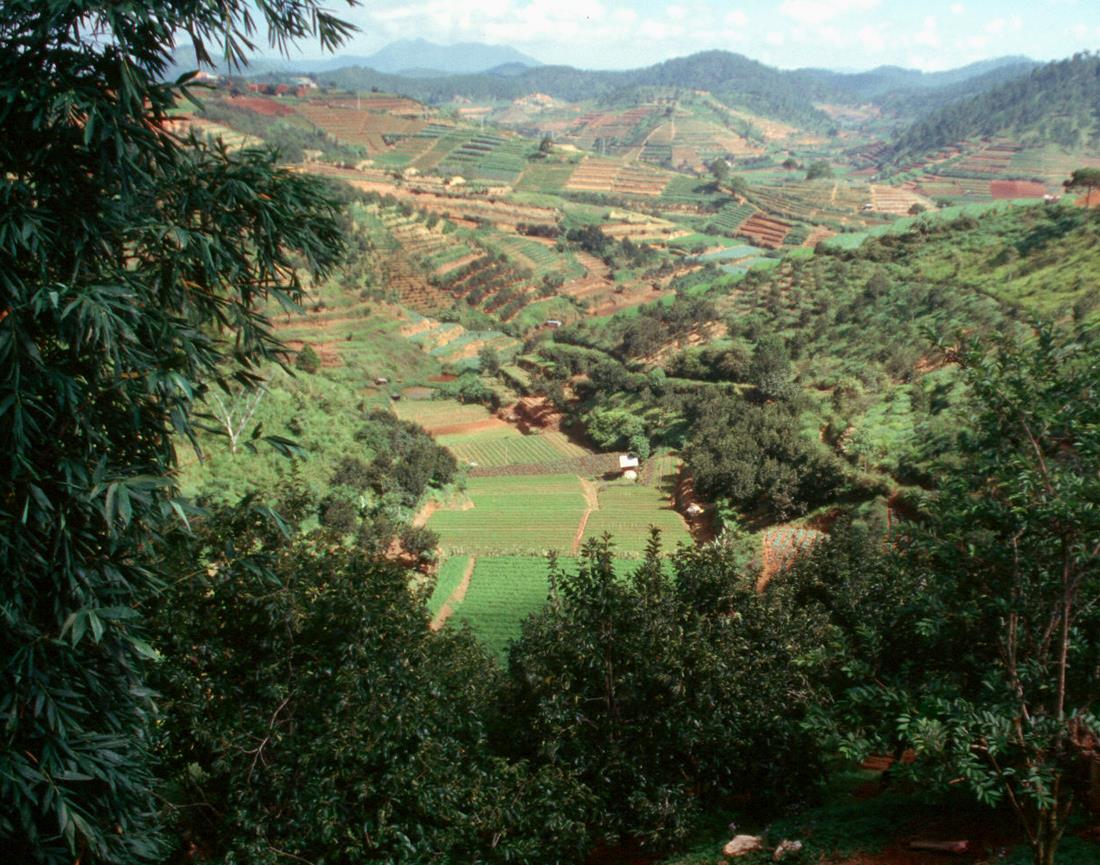
In a further initiative, over the last 20 years, agroforesters have been working to take this strategy to a higher level by starting to domesticate some of the very wide range of tree species that have been the source of locally important food and nonfood products traditionally gathered from the forest (Leakey, 2012b; Leakey et al., 2005a, 2012). The approach here has been to apply well-known horticultural techniques of vegetative propagation for cultivar development (Leakey, 2004; Leakey and Akinnifesi, 2008). Unconventionally, this has been implemented at the village level as a participatory process with local communities, rather than on a research station (Leakey et al., 2003; Tchoundjeu et al., 2006; Asaah et al., 2011). This participatory approach was implemented to ensure that the farmers are the instant beneficiaries of the domestication and that they are empowered by the development of their indigenous and local knowledge. Because wild populations of tree species contain 3- to 10-fold variation in almost any trait of commercial interest (Leakey et al., 2005a), the potential for substantial improvements in fruit/nut size, quality, chemical content, etc. is very large. This means that new, highly productive cultivars yielding good quality produce with the product uniformity required by markets is easily obtainable. Furthermore, because the multiplication process is implemented by vegetative propagation based on mature tissues with the capacity to flower and fruit, the long unproductive period usually associated with tree crops is circumvented, and trees are productive in 2–3 years.
Proof of concept has recently been demonstrated by the implementation of a participatory tree domestication project in Cameroon (Tchoundjeu et al., 2006, 2010; Asaah et al., 2011). In 12 years it grew from 4 villages and a small number of farmers to over 450 villages with 7500 farmers. The flow of benefits, such as income generation, started within less than 5 years (Fig. 28.9), while the farmers are reporting many other ways in which the project has also improved their lives (Asaah et al., 2011). Perhaps the most signifcant outcome has been the fact that young men and women in these communities now see a future for themselves within the community rather than from migration to local towns. In addition, the processing and value-addition of produce from domesticated trees and other crops have been found to provide off-farm employment and to stimulate local enterprise and trade.
Historically crop domestication has been implicated in the rise of civilizations that are settled, politically centralized, socially stratified, economically complex and technologically innovative societies (Diamond, 1997). As the first wave of crop domestication primarily benefited the industrial countries of northern latitudes, it seems that the time is now ripe for a second wave of domestication to favor tropical and subtropical countries and so enhance social equity and environmental rehabilitation worldwide (Leakey, 2012c; Leakey and Asaah, 2013).
The creation of new cash crops from the domestication of traditionally important, highly nutritious and useful species can be seen as the second step towards closing the Yield Gap, because they can generate the income needed to purchase fertilizers and other agricultural inputs (Fig. 34.2). These trees can be used to enrich and improve the farming systems, whether as shade for commodity crops, agroforests on hillsides, orchards, field and farm boundaries, fodder banks, or woodlots. However, farmers have many other competing demands for their money, whether for local ceremonies, health care, children’s education, farm infrastructure, market transport, etc. Consequently, the third step to closing the Yield Gap is to further expand the commercialization of these new tree crops, so creating business opportunities and employment.
Most of the traditionally important products from tropical forests have been marketed locally for centuries. Over the last decade an increasing number of these have been processed as new food, medicinal, nutraceutical, or cosmetic products, based on the fruits, nuts, gums, resins and fibers. Some of these have entered regional and international markets. The marketing and trade of commodities from tropical producers has often been exploitative. So with the emergence of this new trade there has been a parallel initiative to ensure that the producers receive a fair price—see the Fair Trade Foundation (www.fairtrade.org.uk). In addition, ways have been sought to develop marketing partnerships aimed at the propoor commercialization of the traditionally important products derived from indigenous trees (Lombard and Leakey, 2010). These partnerships work to develop the products to a marketable standard and establish strong and viable trade associations that are forward thinking and market oriented. Through these partnerships it is possible to ensure long-term relationships and supply agreements that ensure that the producers remain in the value chain.
We should not forget the importance of livestock in agriculture. The 2020 projections of the International Food Policy Research Institute suggest that we will need 40% more grain and will eat a lot more meat. As we have just seen, we can greatly increase grain production by closing the Yield Gap. Recent developments have also demonstrated that fodder trees can be used to increase the productivity of cattle and goats. The integration of fodder trees and livestock into a farm is one of the elements of diversification that could be part of Step 2.
Another recent development has been the establishment of public-private partnerships between multinational companies, national and international research teams and local producer communities, to promote and produce new products for international trade. Examples include Daimler AG in Brazil who are manufacturing components for the motor industry based on products produced in agroforestry systems by local communities (Panik, 1998), as well as Unilever plc. which is developing a new oil crop for margarine production with communities in Ghana and Tanzania using kernel oil from Allanblackia spp. (Jamnadass et al., 2010).
All of these developments offer a new approach to agriculture, delivered by agroforestry practices (Leakey, 2010), which is more sustainable—environmentally, socially and economically—than current conventional approaches. This model conforms to the concepts of Multifunctional Agriculture promoted by the International Assessment of Agricultural Knowledge, Science and Technology for Development (IAASTD, 2009) which was ratified by over 60 countries in 2009.
